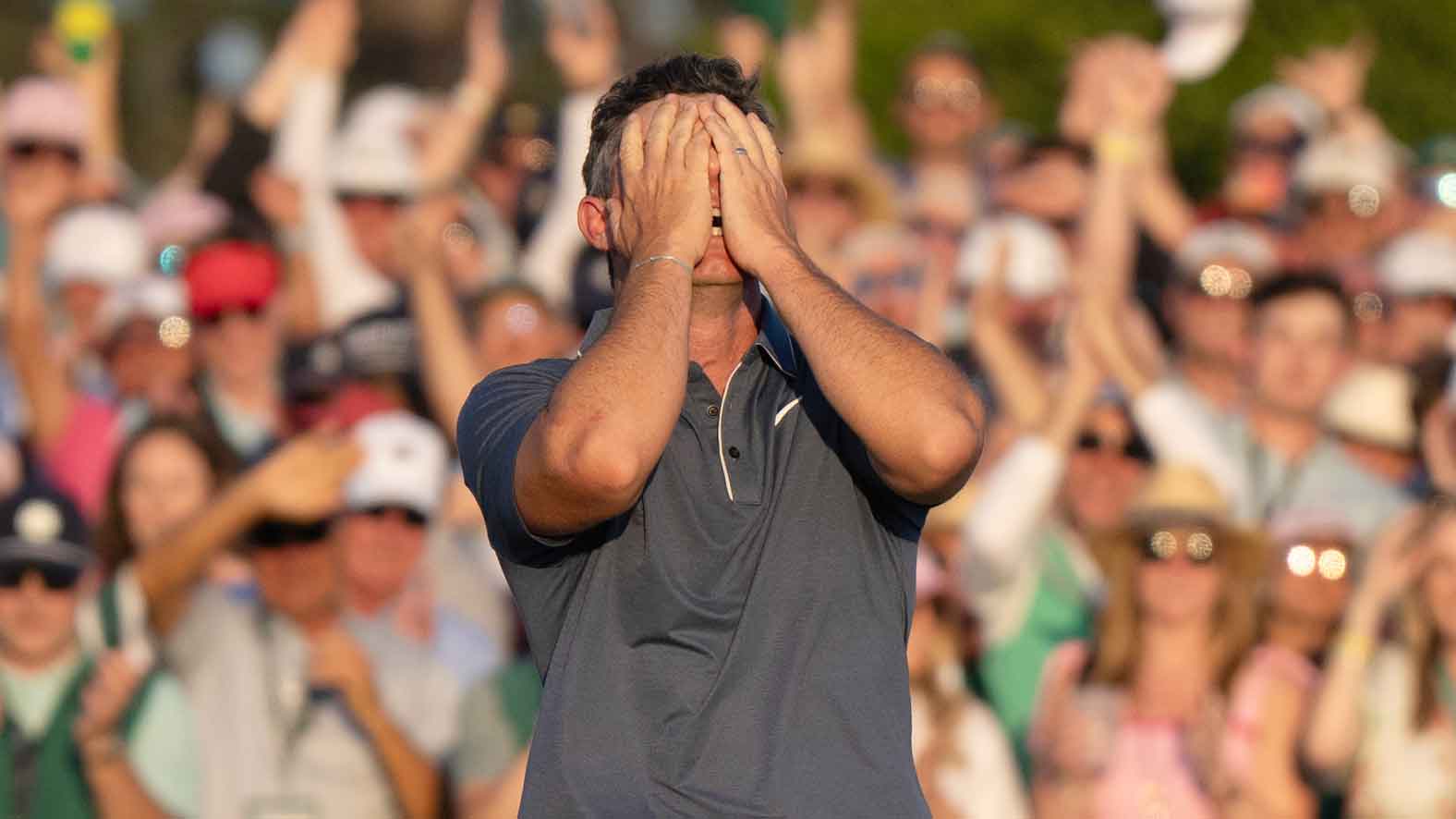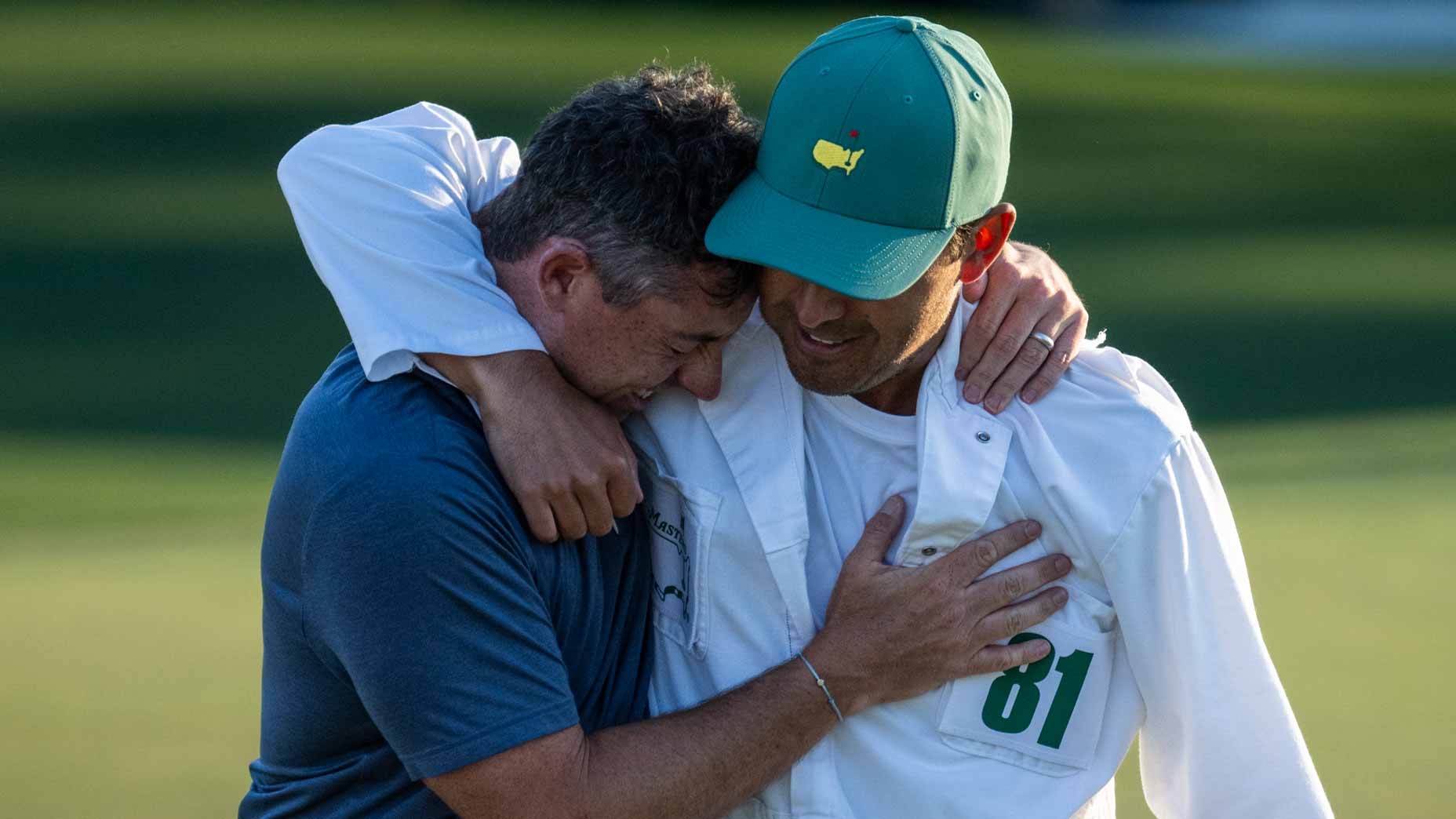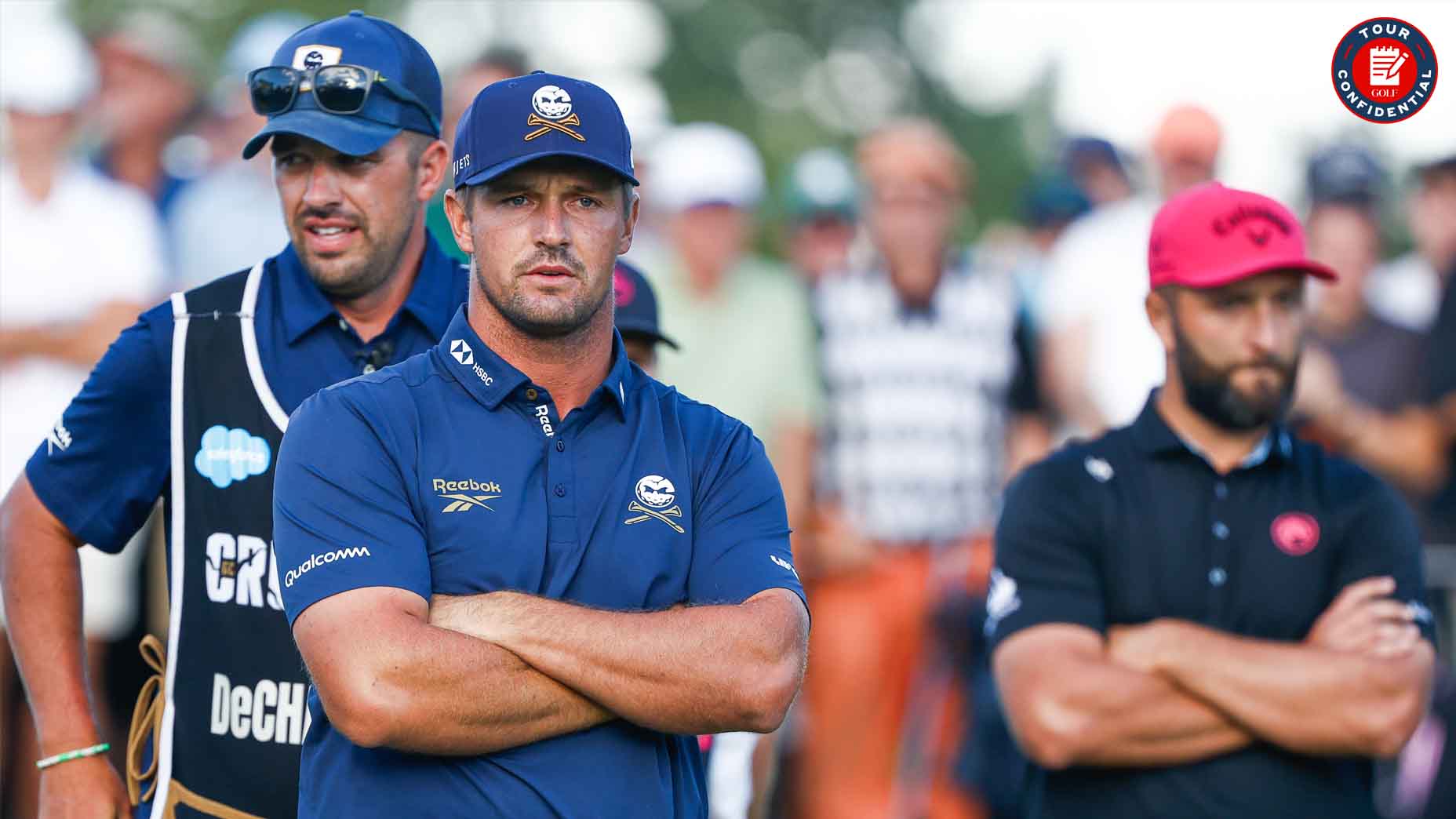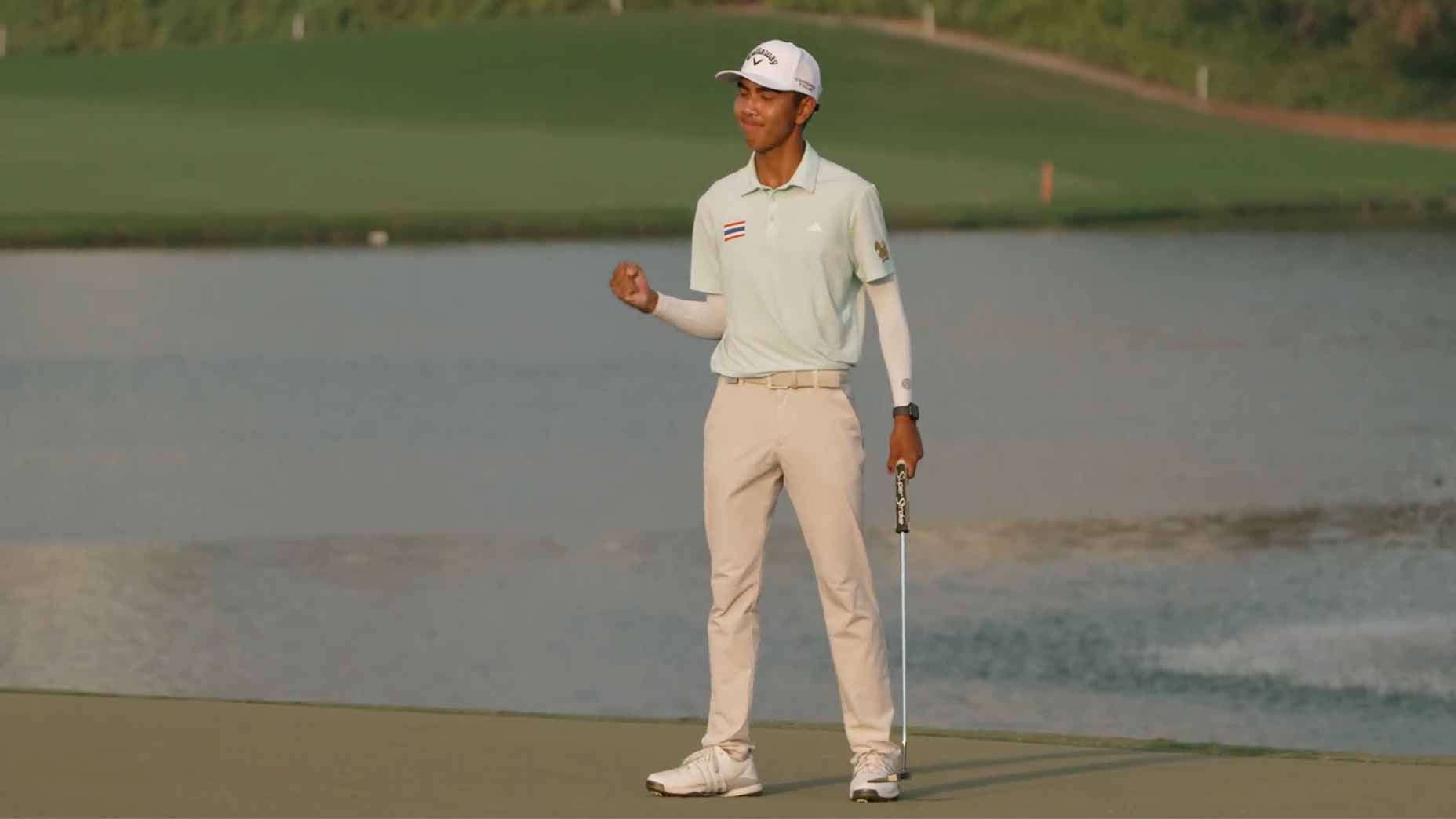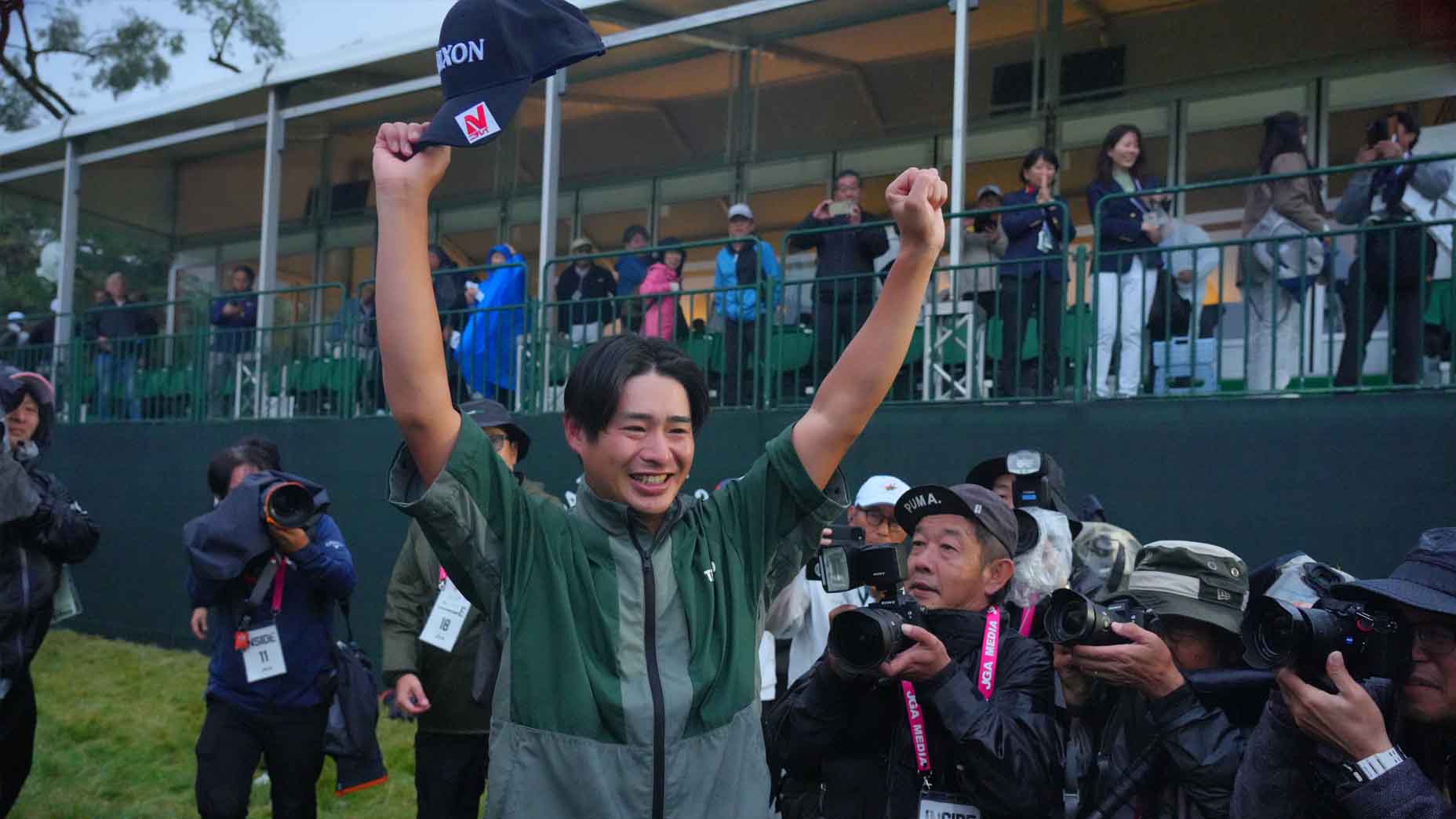It was raining pinecones.
For Sylvia Martin, that was the first clue that something was amiss as she took in the second round of the 2023 Masters from a folding chair to the left of the 17th tee. But Martin and her friend, Jodi Streff, didn’t think much of it. To shield themselves from the woody projectiles, they playfully huddled beneath the canopy of their shared umbrella. Given their prime sightlines, they weren’t about to move. That was until more ominous signs soon followed: Yelling. Gasps. The eerie crack of a towering loblolly snapping clean in two.
Not that Martin and Streff knew what was happening, because all that commotion was behind them. In fact, the only reason they rose from their chairs at all was that someone had urged them to run, so they did — under the rope line and across the tee box, an act that in normal times would be grounds for expulsion at the world’s most famous golf tournament.
Only these weren’t normal times. They were like scenes from a Stephen King film.
“I didn’t know what I was running from,” Martin recalled the other day. “I just knew I was running for my life.”
***
DESHEY THOMAS ALSO REMEMBERS the pinecones, dozens of them falling from overhanging branches and littering the otherwise pristine grounds around him.
Like Martin, Thomas at first didn’t think much of the debris. But unlike Martin, he did notice the three pines behind their chairs swaying like hula dancers. After the group of Adrian Meronk, Kevin Kisner and Louis Oosthuizen had teed off on 17 and made their way up the fairway, Thomas felt the wind freshening. He glanced back up at the trees and that’s when he heard the crack, which many patrons would later say they had thought was the sound of lighting.
From his vantage point, Thomas knew better. His first instinct was to lift the rope line and yell, “Go! Go! Go!” Thankfully, Sylvia Martin did as she was told — at least in part, Thomas believes, because she saw the panic in his eyes. Within moments, the trio of pines crashed to the ground almost simultaneously. Thump-thump-THUMP. One landed squarely where Thomas and Martin had been seated, squashing their chairs and Martin’s backpack as a sledgehammer would a bag of potato chips.
In the shock of the moment, there was much to process. Too much. But to Martin at least one thing quickly became clear: the role Thomas had played in shepherding her to safety.
“If he hadn’t yelled, I wouldn’t have gone,” she said. “He saved my life.”
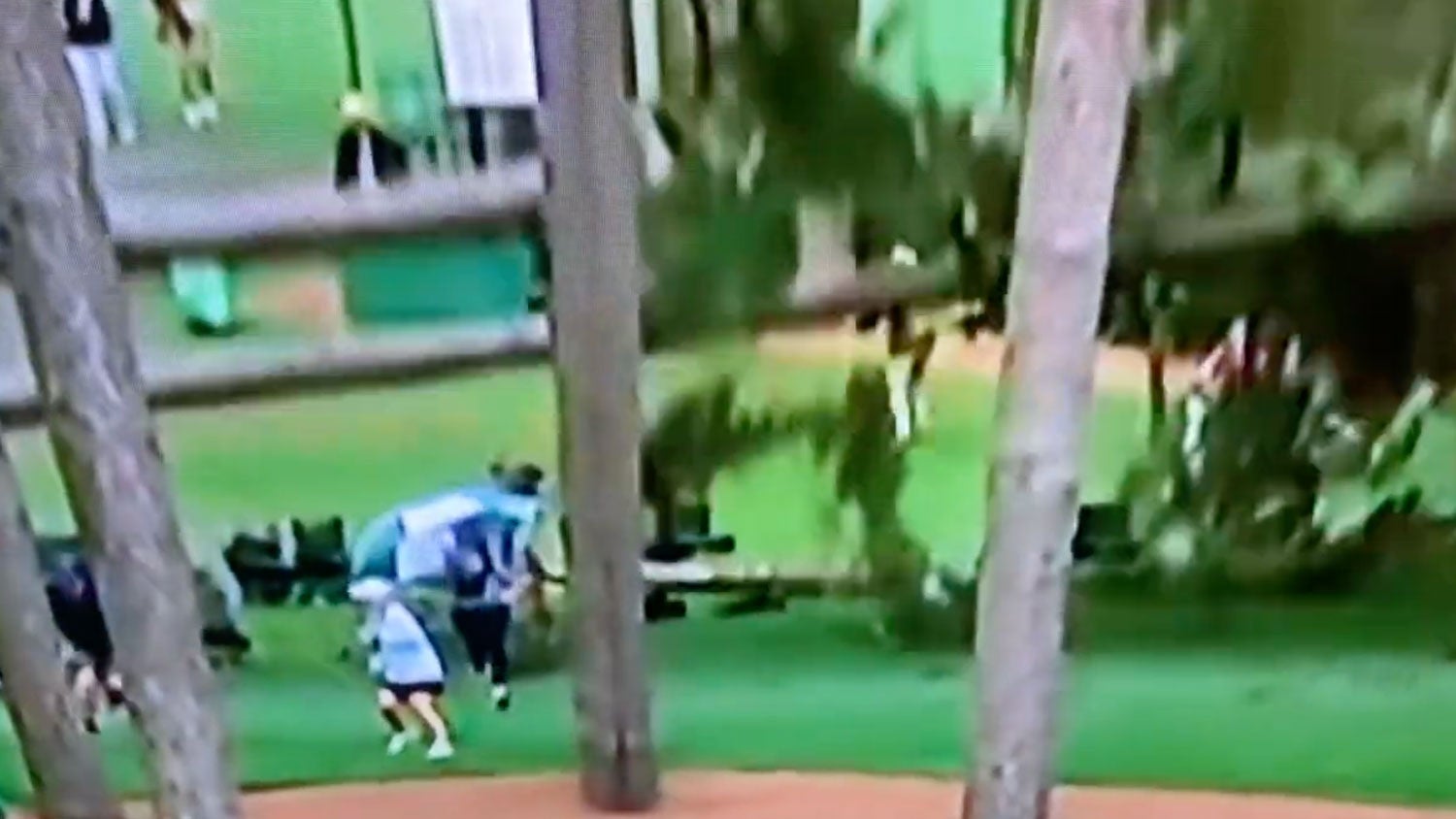
***
THE 2023 MASTERS WAS CHARGED, and not just because it was the setting for the year’s first much-hyped commingling of LIV stars and PGA Tour loyalists, some of whom would share a meal together at the Tuesday-evening Champions Dinner. There was literal electricity in the air. On Friday, the tournament pushed up tee times 30 minutes with inclement weather expected later in the day. By mid-afternoon, a storm cell had moved in, and at 3:07 p.m. officials suspended play, with players and patrons ordered off the course. The interruption was short-lived, however, and roughly 20 minutes later balls were back in the air as patrons streamed back to their posts in the pines.
Lobollies, or Pinus taeda, are not only all over Augusta National but also all over the United States; according to the U.S. Forest Service, they are the country’s second most common tree species behind the red maple. The trees typically mature at around 150 years and reach heights from 60 to 100 feet with trunk diameters of about 3 feet. They are hardy and heat resistant and can thrive in many soil varieties but, like humans, over time they also grow weaker and more susceptible to outside forces.
“A lot of the trees out at Augusta National are older and larger trees, and a lot times with old age, you can have issues of windthrow,” said John Traylor, a forester with the Georgia Forestry Commission. “Also, being out on a golf course, it’s more of a manufactured landscape rather than a natural landscape so that element can play into it as well.”
Traylor said heavy watering can also weaken roots as can rainstorms like the one that soaked the course that Friday afternoon.
“The other thing you have to think about at a place like Augusta National,” Traylor added, “is those fairways act almost like wind channels, and if you’ve big open areas that is carrying the wind, that can put a lot of pressure on those trees as well.”
Trees don’t fall often at the Masters but the 2023 incident was not without precedent. During a thunderstorm on the Tuesday night of the 2012 edition, a slayed pine crushed a bathroom facility by the 16th hole, which would not have been apparent to most first-round attendees. By Thursday morning, the club had fully repaired the hut with nary a shingle out of place. As with all of its business, Augusta National takes tree care and management seriously. A superintendent volunteering on the grounds crew at last year’s Masters told GOLF.com that the club not only has a full-time horticultural team but also certified arborists on retainer.
Last year’s tree scare was extraordinary because it happened in the heat of the action, with hundreds of patrons and several players and caddies about. The disruption, which unfolded less than an hour after play had resumed, was exceptional for other reasons, too. For one, the weather wasn’t that wild. It was damp and overcast and breezy but never felt unsafe. The mighty gust that uprooted two 10-story-plus trees — a third smaller pine was downed by the force of the other two — was not representative of the general conditions.
The real stunner, though, came after the pines had toppled: No one was hurt. Which almost certainly was a result of only a small number of patrons having made their way back to 17 after the round had restarted. That no gallery favorites were coming through the hole at the time was another stroke of good fortune. Martin believes that Augusta’s phone policy also might have inadvertently saved lives. Because no one had their head buried in a device when the trees gave way, Martin posits, the general degree of alertness likely was higher than it would otherwise have been. Miraculous is an overused word but how else to describe the sequence of events by that tee box?
That there were no reported injuries, though, isn’t to say that the experience wasn’t impactful, even traumatic, for patrons who’d been near the line of fire. How could it not have been? One moment, you’re watching golf, chatting with a friend or grazing on a chicken sandwich. The next, you’re staring in disbelief at thousands of pounds of timber, bark and needles that could not only have changed your life but also outright taken it. Martin and Thomas’ intersecting stories from that afternoon represent just two accounts from the many patrons who narrowly averted tragedy but still provide a chilling glimpse of what it was like to walk into a golf tournament happy to be there and out happy to be alive.
Another view of the trees falling on 17 pic.twitter.com/jR431IcdLv
— No Laying Up (@NoLayingUp) April 8, 2023
***
SYLVIA MARTIN WAS BORN in Augusta and lived walking distance from the club, on Eisenhower Road, though only for a short spell. When she was 4, she and her family moved to Houston and later to Oklahoma. By 8, she was playing golf and building the foundation for a lifelong love affair with the game. Martin is 53 today and a realtor in Frisco, Tex., where she lives with her husband, Jimmy; 16-year-old daughter, Lacey; and their three dogs. Her son, Nicholas, attends Southeastern Oklahoma State, where he plays on the men’s golf team. Golf is in Sylvia’s blood, and so, too, is the Masters, which she estimates she has attended 15 or 20 times. She understands the rhythms and rituals of the tournament, and the fastidious manner by which the host club operates. She has her favorite spots for spectating, too. High on her list is left of the 17th tee, which also offers views of the green at the par-3 16th along with peeks at 15.
Martin had access to two passes for last year’s tournament. Neither her husband nor son could make the first two rounds, so she invited her best friend and fellow Frisco realtor, Jodi Streff, to what would be Streff’s first Masters. Thursday was hot and sunny. Sunburn weather. Friday’s forecast was less promising, so the friends layered up in Masters quarter-zips and toted an umbrella. As Brooks Koepka ascended the leaderboard — at day’s end, he would be three shots clear of the field — conditions stayed dry and warm. Then a mid-afternoon storm rolled in. When the siren sounded, signaling a suspension of play, Martin had been to enough Masters to know that not all stoppages drag on. So, she and Streff slow-walked their way back toward the clubhouse, hopeful play would quickly resume. It did. When the all-clear was issued, Martin and Streff trekked back to 17 and set up their chairs about 10 or 15 yards from where they had been stationed before the delay.
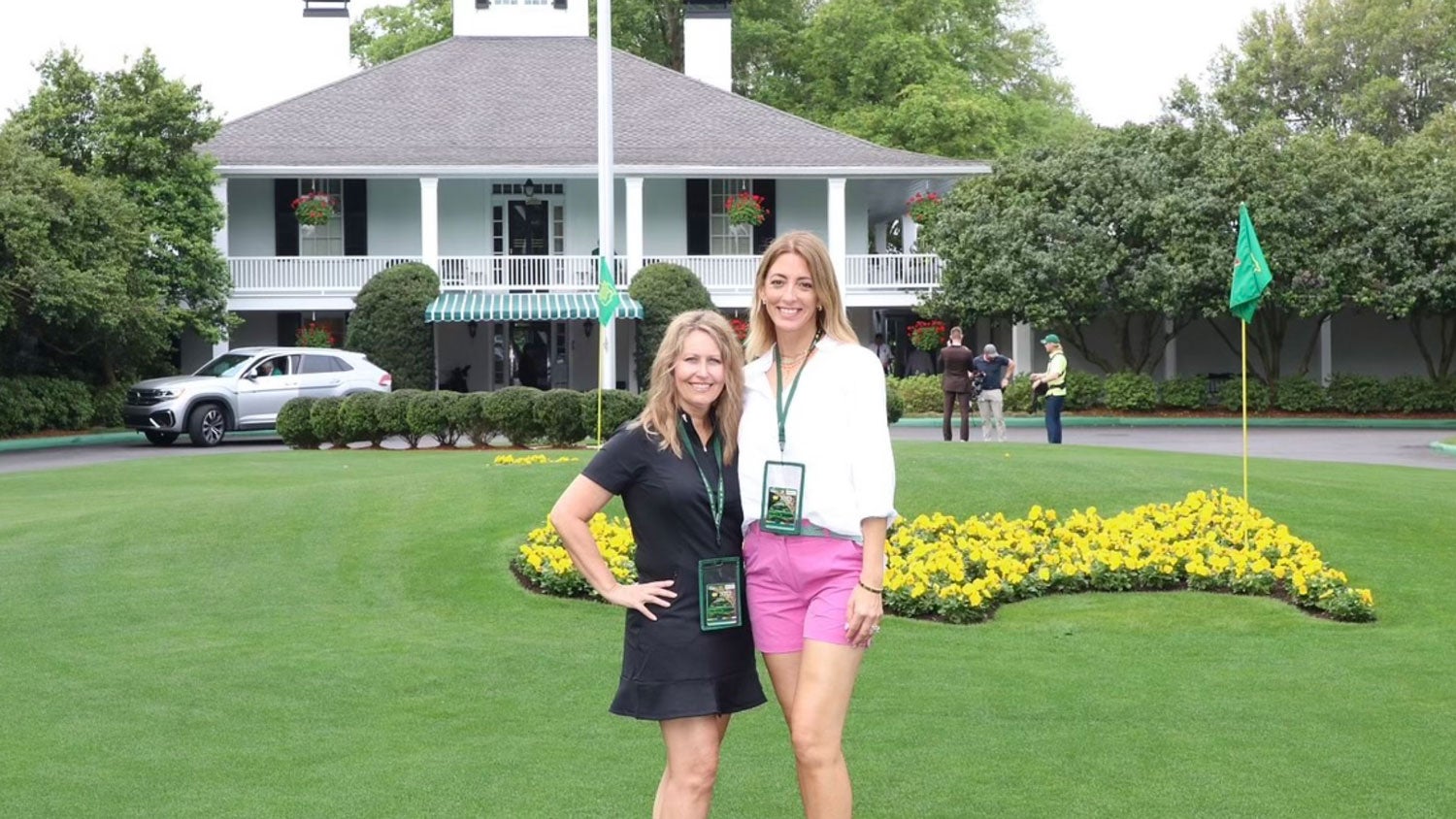
In a chair to Martin’s right was DeShey Thomas, a logistics manager from North Carolina. He was in a black-and-grey pullover and a red Callaway cap. They started chatting, as Masters patrons do with one another. “You talk to the people around you,” Martin said. “You make friends.”
They would soon share a bond that would unite them on a far deeper level.
***
DESHEY THOMAS GREW UP on a golf course. His family’s house was just off the 8th fairway at the now-defunct Crooked Creek Golf Club in Fuquay-Varina, N.C., just south of Raleigh. He and his friends played a bit but never took golf too seriously. Soccer was DeShey’s game, which he played at the club level at East Carolina University. He is 32 today and lives just east of Raleigh, in Knightdale, with his wife and young daughter. He plays golf a couple of times a week at public courses around the area.
Thomas had never been to the Masters, so when one of his college friends scored tickets last year and invited Thomas and two more of their college buddies to tag along, Thomas jumped at the chance. He was excited not only to see the course but also to watch Tiger Woods, who Thomas had grown up idolizing. “People say we look alike,” Thomas said. He added, “I’ve followed Tiger’s journey a lot. I knew his leg was kind of bothering him, but that was a huge deal for me, seeing him play.”
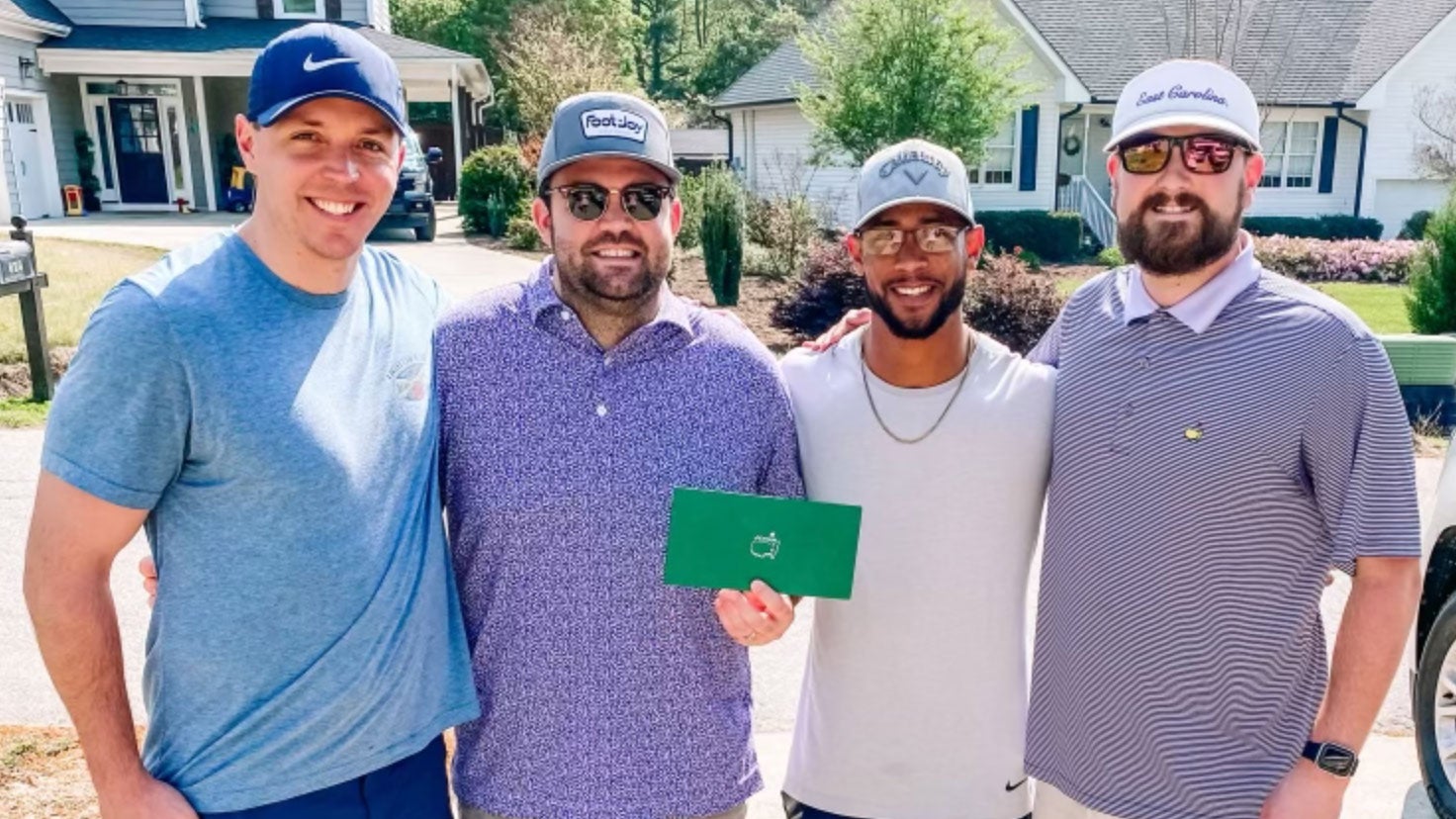
Thomas’ friend had only two passes for each round so on Wednesday of Masters week, he and his friends played a golf match in Raleigh to determine who would get to attend which rounds. Low scorer would get first pick and so on. Thomas wound up with Friday and Saturday access.
On Friday, Thomas was pleasantly surprised when the rain held off. He and his friend pitched their chairs at 16 near the spot of Woods’ famous 2015 chip-in. They stayed there until the horn blew that afternoon, at which point they packed up and began heading back toward the clubhouse. They didn’t get far before the suspension was lifted. Instead of returning to 16, though, they elected to position themselves for the tee shots on 17. Thomas set up his chair next to a friendly patron from Frisco. “We were talking, like, chit-chatting, catching up and I was telling her this was my first time at the Masters and how we kind of got there and some of the cool shots we saw,” he said. “And I just remember the pinecones kept falling. More than I had ever seen before.”
***
AT LEAST A COUPLE OF DIFFERENT cameras caught the moment the trees came down, and from the footage it’s evident that the cracking sound of the wood tipped off many of the scores of patrons in the area as to what was about to happen. Larry Mize, the 1987 Masters winner in the group on 16, seemed to know what was coming. A few moments before the loblollies crashed down, he was standing by the bunker on the 16th green staring up at them. “Scariest situation that I can remember,” Mize told reporters later. “It could have killed somebody.” Players on 15, Keith Mitchell among them, also could see what had unfolded. “Took my breath away,” Mitchell said, speaking for viewers across the globe who watched and re-watched replays of the shocking near-disaster in the minutes and hours afterward.
After Thomas had implored Martin to get moving, here is how Martin recalls the terrifying moments that followed. This account has been lightly edited for clarity:
He lifted the rope and we all just ran. Did not know what we were running from. Had no idea. Everybody just ran. When I turned around is when I saw a tree falling. You can tell in the video if you can see me running and my friend, we would talk about how the fact that you kind of had your shoulders up because you didn’t know what you were bracing yourself for. We just knew something bad was happening. I will never forget turning around and seeing the tree coming down. It hit our chairs. One of our chairs got squished to the point it was trapped under the tree, and we couldn’t get it back. My backpack had been right there, and it blew the sides out. When I turned around, I didn’t want to look at first because I didn’t want to see an injured person. And I didn’t know if the tree injured anybody because it all happened so fast. My legs just kind of went numb. I was just like, what is happening?
Walking back over there, everyone was in shock. When they [tournament officials and volunteers] were trying to help everyone gather their stuff, I’m sure it was one of those things kind of like, okay, we all don’t know what’s happening. We better get everyone out of here because it’s something tragic going on. I just started crying because the guy was, like, trying to get the stuff together, and we got one of our chairs, which was smushed, but we were able to get it. And they said, Where’s the other one? And we looked and when I realized what my backpack looked like, we knew we had just been sitting there seconds before — it really just kind of hits you that it’s like, okay, I almost died.

As startled patrons inspected the felled trees and came to grips with what they’d just witnessed, tournament officials snapped into action. Just a couple of minutes after the trees fell, a horn blew, at 4:22 p.m., ending play for the day. An hour and 23 minutes later, the club issued a statement that read, in part, “The safety and well-being of everyone attending the Masters Tournament will always be the top priority of the club. We will continue to closely monitor weather today and through the tournament.” Down at 17, workers with chainsaws cut up and cleared the trees with clinical efficiency. In classic Augusta National fashion, the mess was gone seemingly as quickly as it had been created.
For some, though, memories of the incident have been harder to erase.
***
IN THE MOMENTS AFTER the trees came down, anyone who wanted to call their loved ones to let them know they’d experienced or that they were okay couldn’t immediately do so because of the Masters’ phone policy. As he walked back toward the exit with his friend, Thomas remembers thinking what an odd sensation that was, not being able to call his wife. As they neared the scoreboard by the 1st fairway, though, he heard another familiar voice.
“That’s the guy who saved my life,” a woman cried out.
It was Martin. She and her friend were talking to an Augusta Chronicle reporter about their experience at 17.
“And I’m like, ‘Wow, I didn’t realize it,” Thomas says now.
Overcome with gratitude, Martin embraced Thomas. Even today, though, Thomas is reluctant to accept praise. “I wouldn’t say I was a hero,” he said. “I just acted quickly. You know, the fight or flight kicks in.”
By the time Thomas got off property, videos of the collapsing trees were lighting up social media. Thomas called his wife and daughter; his parents and grandparents had also called to check on him. In the months since, Thomas and his friends who were with him that week have rehashed the craziness of the 17th-hole episode on a group text, sometimes spurred on by when one of them spots a mention of the downed trees in the media.

Soon after she returned home to Frisco, Martin tracked down Thomas on Facebook. She wanted to thank him again. Over the next two or three months, they continued to exchange messages to see how the other was holding up. “When you live through something like that, it’s traumatic,” Martin said. “You kind of feel bonded to people that were around you.”
After they left the course that Friday afternoon, Martin and Streff drove nearly three hours from Augusta back to Atlanta, from where they had a flight home Saturday morning. They dined together that evening but didn’t feel much like talking. “We just kind of sat there in silence collecting our thoughts and our emotions of all the what-ifs,” Martin said. “If this had been a couple hours earlier, would we have been able to run? Would the crowd have been able to run?”
Martin said that she and Streff have joked about the wild nature of Streff’s first Masters. “I brought her here hoping this would be the experience of a lifetime,” Martin said. “But that definitely wasn’t the experience I was trying to give one of my best friends.”
Or, for that matter, herself.
For weeks after the incident, Martin said she had nightmares about the trees. “I would just hear the cracking sound and scream again,” she said. “Then I would wake up kind of sweaty, kind of, like, just thankful to be alive. You just can’t believe that you lived through something like that.” Unexpected noises, like the sound of a bird landing on her car’s sunroof, would also take her back to 17.
Martin has a box in her house full of merchandise she bought at last year’s Masters and had shipped to her home from the tournament, a common practice among patrons. The package is still sealed. She said she hasn’t “felt the need to go through it. It’s almost like I don’t even want to talk about that Masters.” She never recovered her crushed chair — “I don’t know where it went,” she said — but she did bring home her backpack, which for months served as a raggedy reminder of the week. Eventually, she decided to dispose of it. “After a while,” she said, “I couldn’t look at it.”
Neither Martin nor Thomas said they harbor any ill will against the tournament or club for what they went through. “It’s not like I don’t like the Masters, because I obviously I want to go back,” Martin said. “It’s a part of my life. It’s a part of my history. I’ve always loved the Masters. It’s the ultimate golf tournament.”
Time has helped Martin get through the shock of that afternoon, she said, and so, too, has her schedule. “Life gets really busy,” she said. “I’ve got kids and three dogs, and I work. When life gets busy, you’re able to just keep moving. Maybe some people can’t, but I did. That’s the way I look at it. I was able to just keep moving after that.”
Thomas also hasn’t spent much time replaying the events at 17 in his head. But there are exceptions, he said: “Even on the golf course now, if I see a huge pine and it’s a windy day, I’m kind of looking up and reliving that moment.” The fast-approaching one-year anniversary of that day, he said, also has had him thinking more about the bark-covered bullet he dodged.
“You never know how quickly life can come and go and how unexpected things could happen out of nowhere,” he said. “Part of my perspective is just not taking any days for granted. Like, it was the best news I’ve ever gotten. When I walked on the grounds, I was, like, this is what they talk about. The Masters. And then it goes from being the best day of your life — of being at the Masters for your first time — to what could have been the worst day of my life as well.”
***
THERE IS AT LEAST ONE PATRON who had a more harrowing experience at 17 than either Thomas or Martin, and Martin can’t shake the image of her. “The lady in the black dress” is how Martin describes her. If you’ve watched replays of the moment, you also might have spotted this woman, because as two of the pines crash down they miraculously — there’s that word again — settle on either side of her. The woman was physically unscathed but presumably shaken to her core.
Martin had remembered the lady in the black dress from earlier in the day because another patron had been talking the woman’s ear off. “We were just kind of talking, like, oh my God, he won’t leave her alone,” Martin said.
And then, in a horrifying and unthinkable instant, the lady in the black dress suddenly found herself flanked by two fallen loblollies. The improbable scene called to mind the famous stunt from the 1928 silent film “Steamboat Bill, Jr.” starring Buster Keaton, when the façade of a house collapses on Keaton. He avoids disaster only because he’s fortuitously positioned precisely in the location of an open window.
“I wish I knew the lady’s name,” Martin said. “I so wish I knew her because I would just love to know how she felt and how’s she she’s doing.”
Golf is often described as a game of inches. That Friday afternoon at Augusta National was a reminder that life can be, too.


